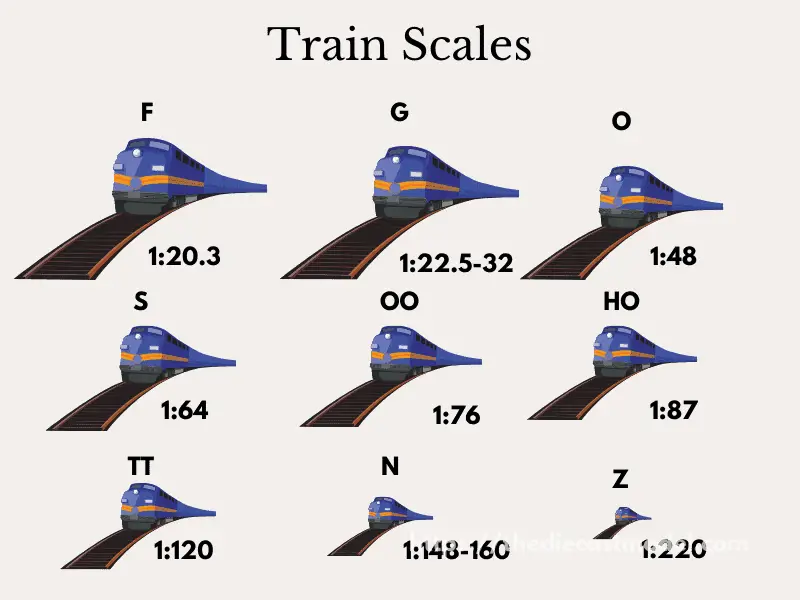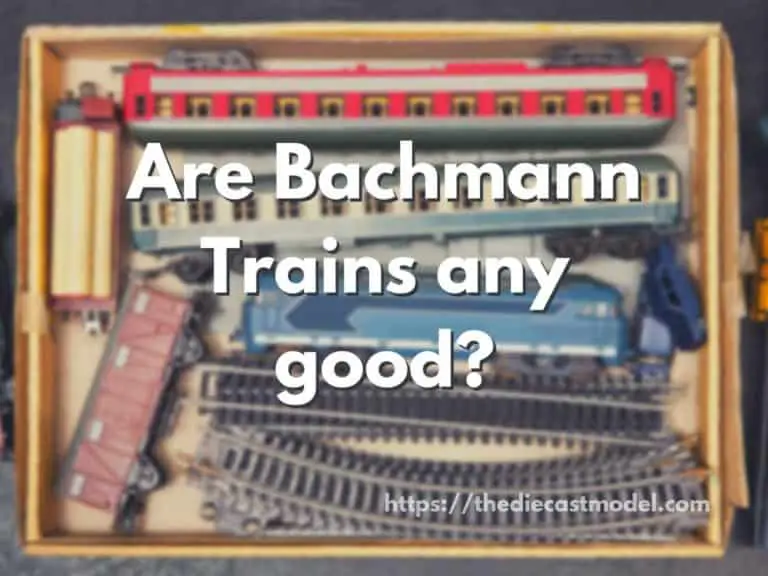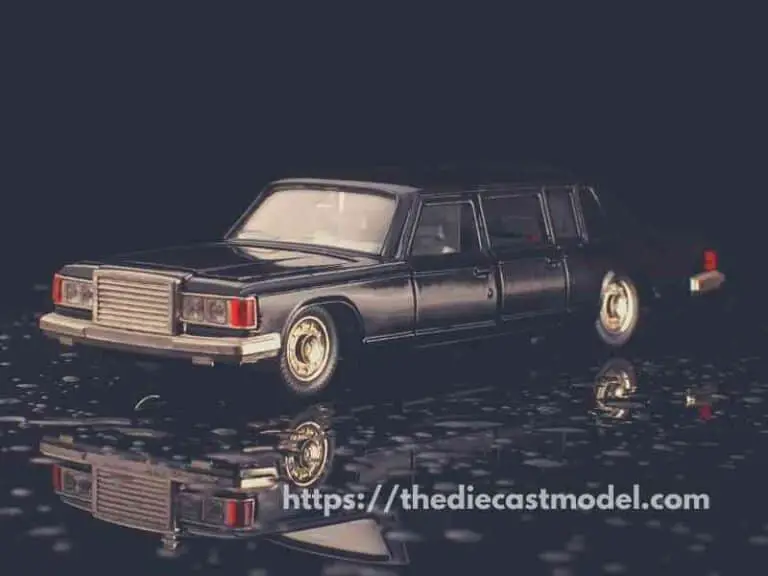What are the Different Scale Model Trains | Train Scales and Their Differences
Model trains have been around for more than a century, and it is a fact that there are lots of model train scales that are available worldwide. This post summarizes all the different scale model trains and their differences from one another.
The different scale model trains are the HO, OO, N, O, G, F, S, Z, T, and TT scales. Each of these scales has its own uniqueness with regards to scale size, gauge width, origin, and history. The largest among these scales is the F scale, and the smallest is the T scale. The most popular scale is the HO and OO, followed by N, then the O scale.

What are the differences between each model train scales?
| Name Origin | Scale | Oval Layout Size | Standard Gauge | Comment | |
| HO Scale | Half O | 1:87 | 4 x 8 ft | 16.5mm | Most Common Scale US |
| OO Scale | Double-0 | 1:76 | 4 x 8 ft | 16.5mm | Most Common Scale the UK |
| N Scale | Nine Millimeter | 1:148, 1:160 | 2 x 4 ft | 9mm | 2nd Most Common Scale |
| O Scale | Gauge 0 | 1:48 | 5 x 10 ft | 31.75mm | Third Most Common Scale |
| G Scale | Garden, Gauge | 1:22.5, 1:24, 1:25,1:29, 1:32 | 7.5 x 10 ft | 45mm | Largest Commercially Available Train |
| F Scale | Fifteen millimeters to 1 foot | 1:20.3 | 7.5 x 10 ft | 45mm / 70.6mm | Largest Scale Train |
| S Scale | Half of Gauge 1 | 1:64 | 4.5 x 9 ft | 22.5mm | One of the Oldest Model Train Scales (1896) |
| Z Scale | Z for Last Smallest Scale | 1:220 | 1 x 2 ft | 6.5mm | Smallest Commercially Available Scale |
| T Scale | Third of N | 1:450, 1:480 | 0.5 ft x 1 ft | 3mm | Smallest Scale, Only in Hong Kong |
| TT Scale | Table Top | 1:120 | 3 x 6 ft | 12mm | Halfway Between HO and N scale |
I am going to explain the scales individually in this post. Feel free to check whichever interests you.
I also put some comments on what makes the scale unique.
Before I start, I would like to give an arrangement of these scales from the largest to the smallest
Here is an Arrangement of Train Scales from Largest to Smallest:
- F
- G
- O
- S
- OO
- HO
- TT
- N
- Z
- T
F scale
The F scale is considered as the largest train scale. It is on the 1:20.3 scale, which means the actual train is only 20.3 times larger than the model.
The F scale is the solution for the confusing G scale. If you check the table above, you can see that the G scale has many different scales ranging from 1:22.2 to 1:32.
G scale is a unique scale since it follows their gauge, which is 45mm. The thing here is that the G scale adjusts the scale to fit the gauge, which is unique to other scales.
That’s why the G scale has a lot of scales. To solve this, manufacturers built the F scale, which is specific to 1:20.3.
The F scale, like other scales, has a fixed scale. Thus, it has two gauges with are their narrow and standard gauge,
The F scale narrow gauge is 45mm, similar to the G scale. That’s why most G scale trains can run on F scale and vice versa.
The standard gauge for the F scale is 70.6mm, which makes it the largest train scale.
However, it is also worth noting that while the 70.6mm is considered as the standard gauge for the F scale, the 45mm gauge is more common.
Thus, finding a 70.6mm gauge F scale model is very rare. So, it is sometimes thought that all G scale models can run on F scale tracks.
However, while rare, there are standard gauge F scale tracks that aren’t compatible with the G scale.
This content was originally posted on thediecastmodel.com. If it appears on other websites, it is a violation of the copyright owned by thediecastmodel.com.
G scale
The G scale is considered as the largest commercially available train scale. In addition, compared to other scales, the G scale is regarded as the most durable and the scale used for outdoor layouts.
The G scale’s name comes from the word “Garden” because the scale is designed for garden layouts.
Since it is designed for gardens, the G scale train model tends to be the most durable and weather-resistant train model.
These train models are made with durable materials, unlike other scale models.
Some modelers think that the G scale comes from the word gauge simply because it is the only scale that varies because their gauge is constant.
All G scale models run on a 45mm gauge track, so they call it the gauge scale.
This is also why the scale of G scale models varies from 1:22.5 to 1:32.
This makes the G scale unique.
Recommended Read: For more information regarding G scale trains, I recommend you read my post about LGB trains, a popular brand for G scale models. You can find the post here: Everything You Need to Know about LGB Trains.
O scale
The O scale was once the most popular scale. However, this scale lost its popularity due to its price and people’s lifestyle changes. Currently, it is the 3rd most common train scale.
In the early 20th century, the O scale is considered the most popular scale. Most train brands such as Lionel are still popular for this scale.
One of the reasons for the popularity of the O scale is that it came from gauge 0, which is an older way of naming train sizes.
In the past, a gauge is used to name the size of the trains. The larger the number, the bigger the train.
For example, when we say gauge 0, this is equivalent to 1:48. Gauge 1 means the model is 1:32.
This is where the O scale came from, and it was once the most popular scale.
There are many vintage O scale model trains online, and the market is still active because of its popularity.
However, in the 1960s, people started to prefer HO scale models as the population increased. People are beginning to live in smaller places which mean they have less space for large O scale trains.
Thus, they decided to prefer HO, which is half the size of the O scale.
Currently, the HO scale accounts for 60 to 70% of the model trains sold in the USA.
S Scale
The S scale is considered the oldest scale, and it traces back to 1896. However, it didn’t gain popularity until the late 1930s.
A.C. Gilbert, president of American Flyer Trains, was the one who popularized the S scale.
At that time, this size isn’t called the S scale. Instead, they are called the 3/16″ O gauge since its relative size to the actual train is 3/16″ to afoot.
Furthermore, the train runs on O gauge tracks. So that’s why they are called 3/16″ O gauge trains.
The term S scale came from NMRA in 1943 when they defined it as the 1/2 of gauge 1, or 1/64 scale.
The American Flyer S scale trains have been sold by Lionel ever since they bought the rights to American Flyer in 1967.
While the S scale isn’t famous for train models, they are the dominant scale for car and trucks models. In fact, Hot Wheels and Matchbox cars use the S scale in their models.
Recommended Read: Are you interested in the history of American Flyers? I made a post talking about the topic, and I also gave some examples of American Flyer models that were sold for a lot of money. You can find it here: Everything You Need to Know About American Flyer Trains.
OO scale
The OO scale is the most popular train scale in the UK. Hornby introduced this scale, which is the product of British model train manufacturers to get into the HO scale market.
When the HO scale market is gaining popularity, British manufacturers such as Hornby have seen an excellent opportunity to sell more model trains.
Thus, they decided to reduce the size of the once most popular O scale train.
However, a problem in their designing phase made them produce the OO instead of HO.
When they designed their first HO scale train, they realized that their motors couldn’t fit inside the locomotive. So rather than redesigning the train’s motor, they decided to make the train slightly larger.
This decision made their models slightly larger but can still fit HO scale tracks. This led to the OO scale.
This is why the OO scale is slightly larger than the HO scale. In context, the OO scale is a 1/76 scale, while the HO is a 1/87 scale.
However, because of its design, this scale model can run on HO scale tracks.
Recommended Read: For more information regarding the differences between the HO and the OO scale trains, feel free to check this post: HO vs. OO Scale
HO scale
The HO scale is the most popular train scale in the USA. The HO scale accounts for 60 to 70% of the total model train sales. It is on the 1/87 scale.
The term HO comes from the word Half-O because it is about half the size of O scale trains.
The HO scale was popularized by Mantua trains, and the scale became a hit
Recommended Read: To know more about Mantua trains, their legacy, and train value, please check this post: Everything about Mantua Trains.
When people started to live in smaller spaces, they began to prefer smaller trains over the O scale. That’s when the HO scale became the dominant train scale in the market.
The HO scale is also considered the cheapest scale since many manufacturers compete for the said scale.
The HO scale is also a beginner-friendly scale since accessories such as trees, buildings, and cars can easily be found on the HO scale.
Recommended Read: Do you want to save money when getting into model trains? I made a guide on what to buy, the questions you need to ask, and the minimum budget for starting model railroading in this post: How much does it cost to start model railroading?
TT scale
The TT scale is the second most popular train scale in Central Europe and Russia. It is on the 1:120 scale. The TT scale comes from the word Table Top since it was designed to be used on a tabletop.
The TT scale is halfway between the HO and the N scale in terms of size.
Please note that the TT scale is different from the T scale, which we will discuss later.
While it is the 2nd most popular scale in Russia and Central Europe, it is not the case in other places such as the USA and the UK.
The 2nd most popular train scale worldwide is the N scale which we will discuss in the next section.
N scale
The N scale is the 2nd most popular scale worldwide, accounting for 20% of the total train models sold. The N scale is also considered the 2nd cheapest train scale and is preferred by modelers living in small spaces.
As the trend goes to smaller living spaces, the N scale became popular.
That’s why they are currently the 2nd most popular scale worldwide, including the USA, UK, Australia, and Canada.
Many modelers prefer the N scale because it saves space and the current technology allows them to be very detailed for their small size.
Furthermore, building a large layout on the N scale saves space as they are almost half the size of HO scale trains.
It is also easy to get into N scale models, and their 2nd hand market is also active. However, they aren’t as active as the HO scale market.
The term N scale comes from the word “Nine” millimeters since their trains run on a 9mm gauge.
Recommended Read: For more differences between the N and HO scale trains, check this post: HO vs. N scale.
Z scale
The Z scale is the smallest commercially available train scale. It was named Z because Z is the last letter of the alphabet which signifies there won’t be a train scale smaller than Z.
That changed when the T scale came because the T scale is now the smallest scale.
However, it is still the smallest commercially available scale since the T scale is only available in Hong Kong.
The Z scale is in the 1:220 scale and was introduced in 1972 at Nuremberg Toy Fair.
T scale
The T scale is the smallest model train scale which is 1:480. It only has a 3mm gauge and is an exclusive product of the Railway shop in Hong Kong.
The term T scale comes from the word “Three” because it runs on a 3mm gauge.
This is the smallest scale that there is a joke among modelers that if they want to make a model train layout inside a model train layout, they will use the T scale.
Another origin of the name T scale is that it is a third the size of the N scale.
Recommended Read: To know more about the T and Z scale differences, feel free to check this post: T vs. Z scale.







